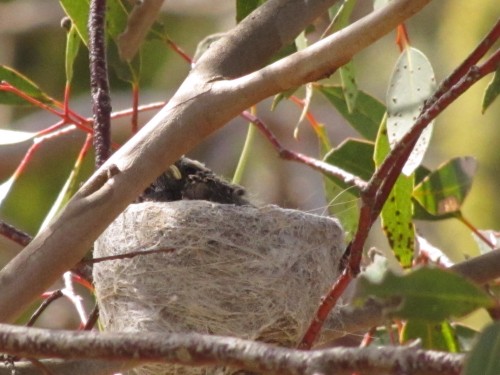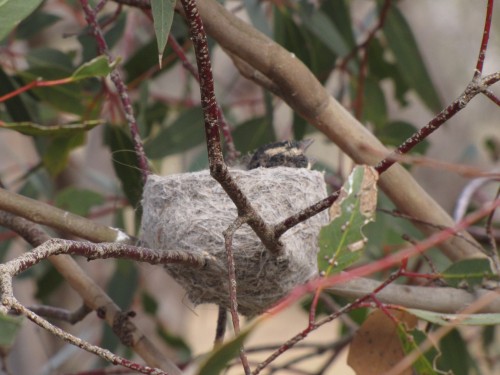Baby birds everywhere
No Comments »12th November, 2015; Category: Baby birds, Bush birds, Garden birds, Murray Bridge, Nests
Over the past month or so the area around our garden has been full of birds nesting, sitting on eggs, feeding young or busy feeding the fledglings after they leave their nest. Spring time here in South Australia is the main breeding season for many species of birds, especially the bush birds. Many of our trees and shrubs are also flowering which means plenty of food for the birds, both the nectivorous and insectivorous species.
Here is an annotated list of the species I have observed nesting or feeding young this spring, plus a few species I suspect have been nesting nearby. All of these observations have been in our garden or on our 5 acre property in Murray Bridge, South Australia.
- Willie Wagtail – the photos of the nest (above and below) on today’s post are of the nest with two babies just peeping over the top of the beautiful cobweb lined nest. They have since fledged and are flying around begging for food.
- Australian Magpie – I knew that our resident magpies were nesting but it was only when the young started calling to be fed that I found the nest. They had made a nest in a completely new tree this year. Last year’s nest tree was blown over by one of our winter storms. (Must cut it up for firewood.)
- House Sparrow – these seem to be always nesting, not just in the spring.
- Common Starling – about a dozen tree hollows had nests in them and it is quite obvious when there are babies in the nest; their calling for food is incessant. Most of the starlings have now flown off to the fruit growing districts nearby.
- Red Wattlebird – there have been several fledged young wattlebirds getting around in recent weeks. I suspect that the adults may well be nesting again. The male continues to boss all the other smaller species quite unmercifully. They don’t like sharing their food, even though there is plenty to go around.
- New Holland Honeyeater – I saw several parents feeding young just out of the nest quite a few weeks ago. They may well be nesting again, but their nests are usually well hidden in dense bushes.
- Peaceful Dove – we saw a pair mating and they have been hanging around close to the house for many weeks. I have yet to find the nest – in part due to a very bad back at present.
- Crested Pigeon – this species always seems to be breeding, but they chose a bush quite a distance from the house this spring.
- Spotted Turtledove – again, due to my back I haven’t yet found their nest.
- Galahs – this one is tragic. After many attempts at breeding over several years in a tree hollow near the house they finally hatched a brood of young, only to see them die in the nest during an unseasonably hot spell several weeks ago.
- Common Blackbird – this species often makes a nest in our garden shed, but this year they seem to be nesting next door and only visit our garden occasionally.
- Australian Magpie-Lark – again, this species has chosen to nest in the neighbour’s tall trees. They visit our garden frequently to catch food for the young.
- White-winged Chough – another species which visits frequently – except in recent weeks. I often see them down the road about a hundred metres away, so they are probably nesting there.
- Little Ravens – although several of this species visit almost daily, I have yet to record them nesting in one of our trees, preferring to keep away from the magpies’ nest, I presume.
- White-browed Babblers – it has been quite a few years since they last nested in our garden but they are regular visitors – except in recent weeks – they must be nesting somewhere nearby.
- Superb Fairy-wren – our resident pair still seems to be around the house garden, but they are very quiet and secretive about the location of their nest.
- Cuckoos – we have heard the calls of the Horsfield’s Bronze-cuckoo a few times several weeks ago but have seen no evidence that they stayed long enough to nest.
- Other possibilities: White-plumed honeyeater, Singing Honeyeater, Spiny-cheeked Honeyeater, Yellow-rumped Thornbill, Weebill, Striated Pardalote, Spotted Pardalote.

